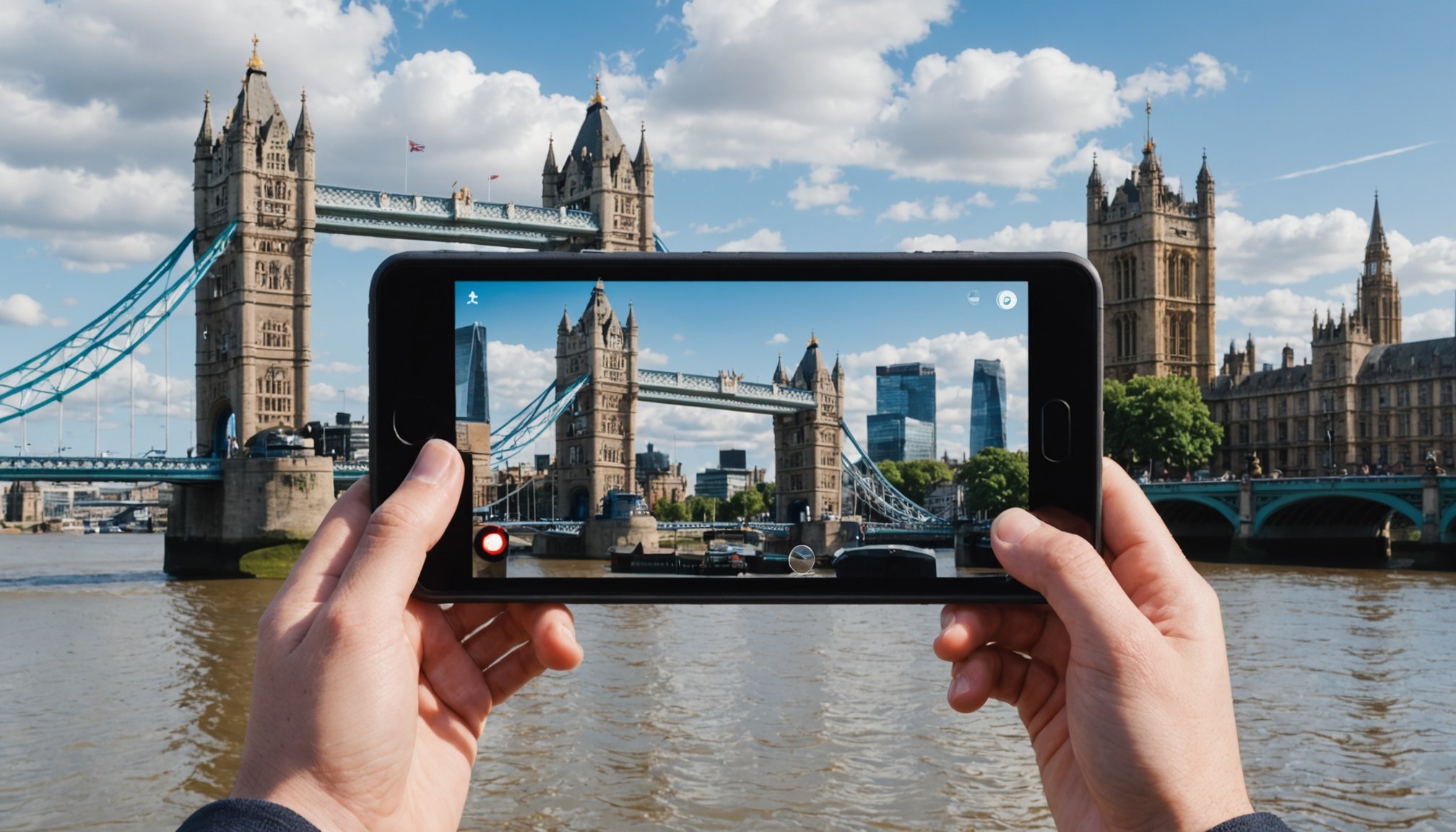Overview of Augmented Reality in Tourism
Augmented Reality (AR) transforms the tourism sector by overlaying digital information onto real-world environments, enhancing visitor experiences. AR uses a combination of software and hardware to enrich physical surroundings with digital insights, seamlessly blending the two worlds. This technology provides dynamic interactions, such as virtual tours and interactive maps, elevating tourists’ understanding and engagement with their surroundings.
The growth of AR technology in tourism is remarkable, providing significant benefits to attractions worldwide. From historical sites to modern galleries, AR enhances visitor experiences by offering immersive storytelling and interactive displays. For example, AR apps allow visitors to visualize ancient ruins as they once were, fostering a deeper connection to the past.
In the same genre : Unlocking transparency: key approaches for uk food producers to enhance supply chain traceability
AR’s ability to present information in an engaging manner is crucial for attracting a younger, tech-savvy audience. Tourists are keenly interested in interactive experiences, making AR in tourism a vital tool for enhancing enjoyment and satisfaction. Additionally, AR assists in navigating unfamiliar terrains, providing real-time directions and recommendations tailored to the user’s preferences.
In summary, the application of AR technology within the tourism industry represents a significant advancement, profoundly enriching the way visitors experience and interact with attractions.
This might interest you : Revolutionizing credential verification: how uk universities can leverage blockchain technology
UK Tourist Attractions Utilizing Augmented Reality
Augmented Reality (AR) is revolutionising how visitors engage with UK tourist attractions, offering interactive experiences that breathe new life into historic sites. Renowned attractions like the Tower of London and the British Museum are employing AR applications to enrich their storytelling. For instance, visitors can use their smartphones to bring ancient artefacts to life, witnessing historical events unfold before their eyes.
The key features of AR applications at these sites include virtual guides, 3D reconstructions, and enriched context layers. These features transform passive observation into active participation, enabling visitors to delve deeper into the narratives. By using AR, tourists can virtually step into restricted areas, explore hidden sections, and interact with exhibits in innovative ways. This technology not only enhances the educational aspect but also stimulates curiosity and deeper understanding of the subject matter.
Feedback from visitors has been overwhelmingly positive. Many describe the immersive nature of these experiences as both entertaining and enlightening, leading to increased visitor engagement and satisfaction. This uptick in engagement levels highlights AR’s potential to attract new audiences while providing fresh value to returning visitors. As such, AR applications at UK tourist attractions are becoming a vital tool in modern tourism strategies.
Benefits of Augmented Reality for Visitor Engagement
Augmented Reality (AR) is revolutionising visitor engagement by transforming static exhibitions into dynamic experiences.
Enhancing Visitor Interaction
With AR, museums and attractions offer interactive learning opportunities that captivate audiences of all ages. Imagine an art gallery where visitors can scan paintings to hear the artist’s story or view animations of how historical events unfolded. This interactivity doesn’t just inform but turns a passive viewing experience into an engaging exploration, making learning memorable.
Increasing Participation and Interest
AR promotes increased participation and interest by enabling visitors to interact with exhibits on a deeper level. Instead of reading plaques, guests can partake in virtual treasure hunts or unlock bonus content related to an exhibit. Statistics show a significant rise in visitor satisfaction when these immersive experiences are available, proving that engaging content retains attention and enhances enjoyment.
Fostering Emotional Connections
Through immersive experiences, AR helps visitors forge stronger emotional connections with history and culture. By overlaying digital narratives onto real-world scenes, participants can step into history or view cultural rituals up close. This emotional engagement makes stories more personal, leaving a lasting impression and encouraging repeat visits. Embracing AR, venues are ushering in a new era of enriched cultural appreciation.
Enhancing Educational Experiences Through AR
Augmented Reality (AR) is revolutionising educational tourism, transforming visits to historical and cultural sites into immersive learning adventures. With AR, museums and attractions across the UK are creating informative experiences that deeply engage visitors. By overlaying digital information onto physical surroundings, AR allows users to interact with historical events and cultural contexts vividly.
For instance, the British Museum has incorporated AR technology to make ancient artefacts come alive, offering detailed background and context through smartphone apps. Similarly, the Tower of London uses AR to recreate pivotal historical events, granting visitors the opportunity to witness battles and ceremonies as if they were truly there.
Such experiences play a significant role in enhancing knowledge retention. When visitors actively engage with subject matter through immersive learning, the retention of information improves substantially. Studies indicate that learning through interactive methods, such as AR, can increase retention rates by up to 90% compared to traditional methods.
Ultimately, AR in educational tourism not only makes learning compelling but also offers unprecedented access to detailed content. This aligns perfectly with modern educational demands for personalised and engaging experiences. Visitors leave UK attractions not just with memories but with a deeper understanding and appreciation of history and culture.
Case Studies of AR Implementation in UK Attractions
Examining case studies of Augmented Reality (AR) in UK attractions reveals valuable insights. For example, the use of AR at the British Museum, which incorporated a historical overlay for exhibitions, showed a notable increase in visitor engagement. Visitor numbers rose by 25% after the integration of AR, demonstrating that innovative AR success stories can captivate audiences.
Similarly, the Natural History Museum implemented AR to create interactive learning stations. This implementation boosted the average visit duration by 30 minutes, highlighting the potential for AR to enhance the educational experience. Such best practices underline the importance of user engagement in assessing the effectiveness of AR.
Critical metrics for gauging success include engagement rates, visitor satisfaction, and revisit intentions. A key lesson from these case studies is to ensure seamless AR experiences that enrich rather than overwhelm. Future projects can learn from these experiences by prioritising user-friendly interfaces and integrating content that truly enhances the attraction’s narrative.
In summary, UK attractions that have successfully implemented AR have followed principles that emphasise creativity, customer focus, and clear objectives, setting standards that could be adapted and improved in upcoming AR ventures.
Challenges Facing Augmented Reality in Tourism
Implementing augmented reality (AR) in tourism poses several challenges. One prevalent issue is the technical barriers involved in integrating AR systems seamlessly. Tourism sites often require robust infrastructure to support AR technology effectively, such as high-speed internet and reliable hardware, which might not always be available. These technical hurdles must be overcome to ensure smooth user experiences and functionality.
Another critical challenge is visitor adaptation to AR. Some tourists might resist using AR due to a lack of familiarity or interest in the technology. This resistance is closely linked to technology literacy issues, where individuals might not possess the skills or knowledge needed to operate AR tools effectively. Educational initiatives and user-friendly designs can help bridge this gap, encouraging greater engagement with AR experiences.
Moreover, balancing the use of AR with the preservation of cultural heritage is essential. While AR can enrich visitor experiences by providing interactive insights and historical contexts, there’s a risk of overshadowing or distorting authentic cultural elements. It’s essential to use AR thoughtfully and responsibly, ensuring cultural integrity is maintained alongside technological advancements. By addressing these challenges, AR can be harnessed successfully to enhance tourism without compromising the authenticity of cultural sites.
Future Trends in Augmented Reality for UK Tourism
The future of AR holds immense potential for transforming the tourism industry, driving tourism innovation and next-generation experiences. As AR technology advances, we can expect significant changes to how visitors interact with cultural sites and attractions in the UK. But how exactly will this technology evolve in the tourism industry? Predictions point to AR becoming more immersive and interactive, providing visitors with a blend of real-world exploration and digital enhancement.
Innovations on the horizon include enhanced AR apps that offer historical recreations at ancient sites, allowing users to witness events from the past as if they’re occurring in the present. Additionally, there’s potential in integrating AR with wearable tech to provide seamless navigational aids or augmented storytelling during museum tours. This tourism innovation could reshape visitor engagement, offering more personalized and enriched experiences.
Moreover, AR is likely to influence new tourist demographics and behaviours. Tailoring experiences for tech-savvy younger generations can open doors to previously untapped markets. This shift presents an exciting possibility for the future of AR applications: to not only attract but also adapt to diverse visitor needs, ensuring sustainable growth in the industry.











